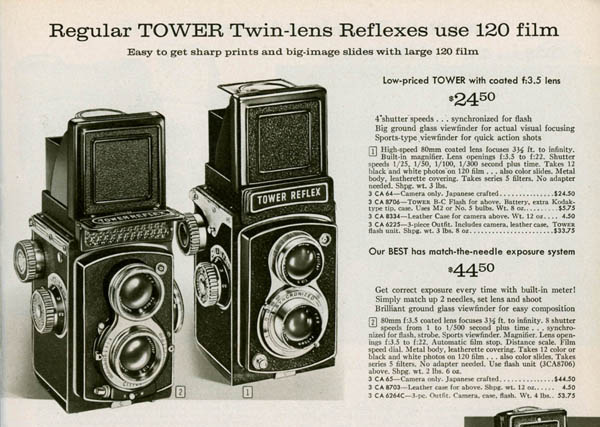
Ansco Anscoflex II
Basic pseudo-TLR, with a geared sliding front which opens top finder.
USA 1954
|

Ansco Automatic Reflex
A classic, complex TLR produced to compete with Rollei/Ikoflex after WW2. It suffered by comparatively high pricing when the Germans restarted exports from the late 1940s. Great over-engineering!
Lens Ansco Anastigmat 83mm f3.5
Shutter Ansco 1 to 1/400
USA 1948
|

Argus Argoflex E
A cheap'n'cheerful US TLR built just after WW2 (1946). Nothing special, but functional.
Lens Argus Anastigmat 75mm f4.5
Unnamed shutter 1 to 1/200
|

Ciro Ciro-flex (Rapax)
Basic focussing TLR from Delaware, 1940s. Rapax shutter to 1/400
Taking lens is Wollensak 85mm f3.5
Rapax shutter 1 to 1/400
|
.JPG)
Ciro Ciro-flex (Alphax)
Another Ciro-flex variant, this one with Alphax 1/200 shutter
Taking lens is Wollensak 85mm f3.5
Alphax shutter 1 to 1/200
|

Craftex Hollywood Reflex
AKA Hollywood Sportsman. Cheap
US pseudo-TLR on which only the taking lens focuses.
USA c.1947
|

Dejur-Amsco Dejur Reflex
Basic US TLR based on the Ciro-flex, but looks rather nicer. c.1952
Lens Dejur Chromotar 85mm f3.5
Shutter Synchromatic 1/10 to 1/200
|

Graflex 22-200
Improved Ciroflex 1953, killed by Eastern competition. 1/200 shutter version
Taking lens Graflex Graftar 85mm f3.5
Shutter Century 1/10 to 1/200
|

Graflex 22-400
Same body and style as the 22-200 model, but fitted with the superior and pricier 1/400 Graphex shutter
Taking lens Graflex Graftar 85mm f3.5
Shutter Graphex 1 to 1/400
|

Kodak Reflex
A real heavyweight camera to carry: Kodak's brief try at the TLR market started here around 1950.
Lens Kodak Anastigmat 80mm f3.5
Shutter Flash Kodamatic 1 to 1/200
|

Kodak Reflex II
Similar to the Reflex, Kodak's brief TLR foray ended in 1951 with this, which feels like carved from solid billet.
Taking lens Kodak Anastar 80mm f3.5
Shutter Flash Kodamatic 1 to 1/300
|

Koni-Omegaflex
Monster 6x7 offspring of Omega (US) and Konica (Japan). Not a true TLR, but the optional reflex finder fits to rear and makes it behave like one. The thumbnail pic links to my "Japanese" pages, since it was actually manufactured by Konishiroku in Japan.
Taking lens Konica Hexanon 90mm f3.5
Shutter Seiko B 1 to 1/500
|

Royce Reflex
Basic cast-aluminium TLR, using gear-coupled lenses. Made in Hollywood - Rick Oleson suggests probably around 1946.
Taking lens Wollensak 80mm f4.5
Shutter Wollensak 1/25 to 1/150
|

US Camera Corp Auto-Forty
Not really American - bought in from Japan - an Accuraflex under the skin. but quite a nice camera, with a "space-age" nameplate. But who made it? I've never satisfied myself on the origins of he Accuraflex and its several siblings under different names. Go to my "Japanese" page and link to "Mystery TLRs" to explore this one.
Taking lens Tritar 80mm f3.5
Shutter "Synchronized" 1/25 - 1/300
|

US Camera Corp Auto-Fifty
Another USC model bought in from Japan. This one is a Taiyodo Beautyflex under the skin, but looks quite neat. It needs re-covering - it's been patched badly.
Taking lens Biokor 80mm f3.5
Shutter Synchro MX 1 - 1/300
|

Universal Uniflex I
Basic TLR, few frills, just about functional. However, see Rick Oleson's comments on its grossly overinflated launch pricing!
Lens Universal Anastigmat 75mm f5.6
Shutter Synchromatic 1/25 to 1/200
USA c. 1948
|

Universal Uniflex II
Pretty similar to the Model I, and presumably similarly overpriced as
was the Mk I.
Lens Universal Anastigmat 75mm f4.5
Shutter Flash Chronomatic 1/10 to 1/200
USA c. 1949
|


